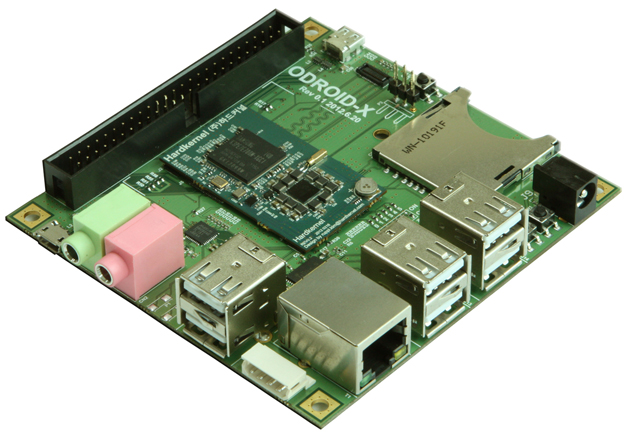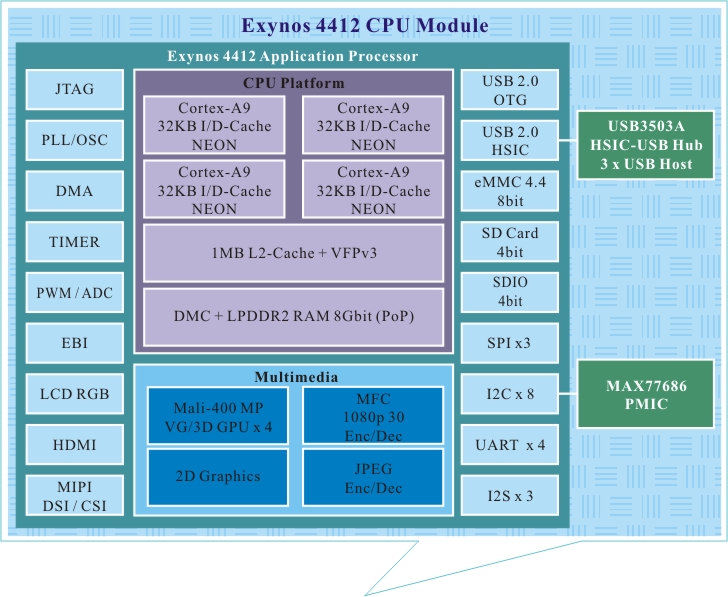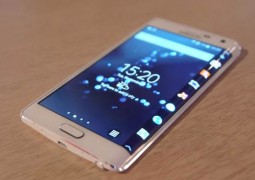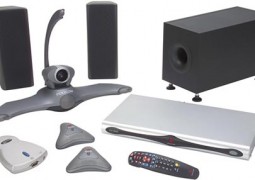Say Hello to The ODROID-X, The $129 Quad-Core Barebones Running Android 4.0
by 14 July, 2012 1:14 pm0
Remember that convenient Raspberry Pi barebones we talked about several times?
Well, just in case you don’t, the Raspberry Pi is a $35 Linux distro computer, that upon launch, became hugely successful. Honestly, it was appropriate to expect such success, because who wouldn’t like a $35 working computer?
The Raspberry Pi inspired VIA technologies to create their own low-cost barebones, which led to the release of the VIA APC, a similar minicomputer running the Android OS.
 Both computers are powered by a single core processor, with the Pi including a 700MHz ARM Cortex model and the VIA APC using a 800MHz ARM11 model. As you’ll notice right away, each computer would be perfect for that quick fix, but they actually don’t have that much power, at least in terms of hardware.
Both computers are powered by a single core processor, with the Pi including a 700MHz ARM Cortex model and the VIA APC using a 800MHz ARM11 model. As you’ll notice right away, each computer would be perfect for that quick fix, but they actually don’t have that much power, at least in terms of hardware.
Enter ODROID-X, a $129 barebones computer running on a Samsung Exynos4412 Cortex-A9 Quad Core processor, with each core clocked at 1.4Ghz. Of course, the processor is still a mobile ARM Cortex model, but a quad core computer is significantly more powerful than a single core; hopefully, we don’t have to convince you of that. Sure, a dual-core processor on a desktop or laptop PC will run faster than a mobile quad-core, but a computer of this size doesn’t necessarily need that kind of computing power.
The ODROID-X $129 Quad-Core Barebones
The ODROID-X is a low-cost mobile development platform running the Android 4.0 ICS operating system. Even though, these types of barebone computers are intended for developers, they make perfect DIY projects and portable personal computers.
As with the Raspberry Pi, and the VIA APC, the ODROID-X does not come bundled with a case or an external shell, which means if you want one you’ll have to add one on your own. The advantage of such a small motherboard is that the possibilities are seemingly endless, you can fit the 3.5 inch motherboard in almost anything.
The ODROID-X Hardware
As we’ve already mentioned, the ODROID-X is powered by a 1.4Ghz quad-core Exynos Cortex-A9 processor and includes 1GB of installed DDR2 RAM (800Mhz). Additional features include six USB 2.0 ports, an HDMI output, and an SD card slot for additional storage support. There is no integrated Wi-Fi, which means you’d have to install some sort of adapter to use a wireless network, but the ODROID does include a 10/100Mbps Ethernet port.
If you’re actually interested in adding Wi-Fi to the board, there is a compatible module for sale here, that works as an internal peripheral, for a mere $9.
We know you’re itching to view the full list of specs, so we’ve included them below for your perusal.
- Processor:Samsung Exynos4412 Cortex-A9 Quad-Core (1.4Ghz)
- Cache: 1MB L2
- Memory: 1024GB DDR2 800Mhz
- GPU: Mali-400 Quad-Core
- Video: 1080p HDMI (H.264+AAC MP4)
- Outputs:
- Video: micro HDMI/ RGB – 24bit LCD Interface Port
- Audio: 3.5mm Headphone Jack/ HDMI SPDIF
- Ports:
- LAN: 10/100Mbps Ethernet with RJ-45 Jack
- USB 2.0: High Speed Standard A Connector (x6)/ Mass Storage (Micro USB)
- IO: 50pin expansion port (LCD/I2C/UART/SPI/ADC/GPIO)
- Software: Android 4.0 (ICS), u-boot 2010.12, Kernel 3.0.15
- Dimensions: 90mm x 94mm
Optional Features
- Display: HDMI Monitor/ LCD Panel with RGB or LVDS Interface
- Storage: SDHC Card Slot, eMMC Module Socket
- Camera: MIPI-CAM Connector (MIPI-CSI 2 lanes)
- Power: 5v 2A Power
If you get your rocks off by browsing hardware diagrams, check out the official site, they’ve got plenty of images that display the actual, exposed, design of the ODROID.
The ODROID-X Has Potential
We don’t have to say it for you, because if you’re a gadget enthusiast, you can see the possibilities for this device are endless. What makes the ODROID even better, is that the manufacturers have included peripherals that can be added to the board in order to increase functionality and support.

If you so desire, you can buy a compatible wireless network adapter, standard and touch-sensitive LCD panels, a 5MP camera sensor, a USB Bluetooth dongle, and of course a power adapter.
Unfortunately, Hardkernel, the Korean manufacturer, has no third-party distributors which means you must purchase from their site directly. In order to obtain an ODROID-X you’ll need an active PayPal account, with some money in it, and currently that’s the only form of payment Hardkernel accepts.
Still, we can’t stress enough how inspiring it is to see a computer of this size is. Sure, the ODROID-X won’t handle graphically demanding games at full blast, but it’s a step in the right direction, and will be suitable for anyone that wants to carry around a mini computer in their pocket.
In case you’re wondering, yes we do have a desire to store a mini-computer in our pocket at all times.




































































